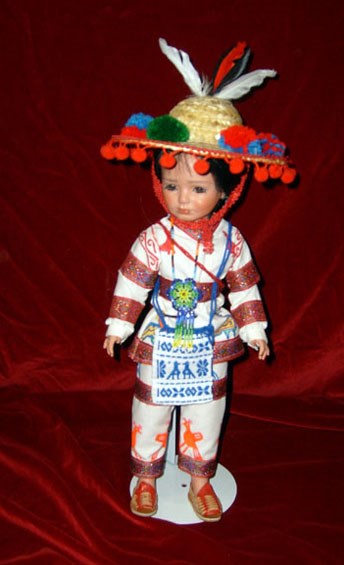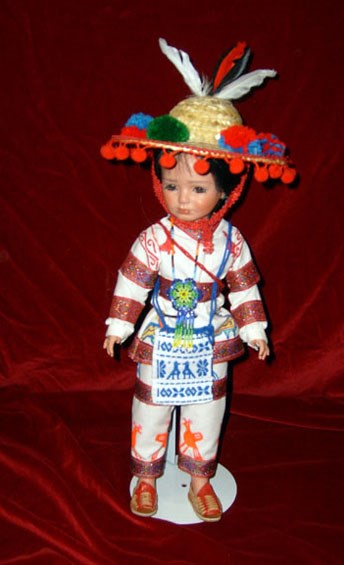
Capital: Tepic Geometric figures, wavy lines, eagles, and royal cranes decorate both the long cotton tunic, called kamirra or kutuni, and the short pants called huerurri. The wide belt, called a kuayame is heavily stitched with a geometric design. Two small bags slung across the shoulders are called a kuchuri and a tubarra. The palm fiber hat, called a rupero, is decorated with feathers and yarn pompoms. Beads, called kuka, or cut glass, chiqirita, are used as jewelry and decorative objects. Nayarit's steep canyons and deeply cut ravines seem to guard the indigenous people who have struggled to exist there for more than 250 years: the Tepehuanes of Huajicori; the Coras in the northern Sierra del Nayar, Rosamorada, and part of Acaponeta; and Huicholes in Yesca. On this state's rugged terrain, they have managed to preserve their traditions and languages while living by their own social and religious norms. Although some part of these indigenous groups have left the mountains seeking sustenance in more urban areas, many have remained in their remote homes, withstanding drought and famine for many generations. Both the Coras and Huicholes are known for the beauty of their ancient apparel. The Huicholes or Wirraritari leave their garments unfinished because they believe only gods can be perfect. Huicholes are known for making the familiar Ojo de Dios (Eye of God) by winding colored yarn around crossed sticks. The weaving is said to protect children during the first five years of life. Although its said that Aztlan was the point of departure for Aztec migration toward the valley of Mexico, there is room for debate, because some scientists say the point of origin of the Aztecs was actually the Isle of Mexcaltitan, to the east of Nayarit. Several sierras traverse Nayarit, and its largest cities have developed in a series of valleys. Nayarit has 289 kilometers of coastline on the Pacific Ocean and numerous islands, including Las Islas Marias - Maria Madre, Maria Magdelena, Maria Cleofas, and San Juanito - which were officially converted to penal colonies in 1905. Several picturesque lagoons such as the Santa Maria del Oro, San Pedro Lagunillas, and Agua Brava are used as tourist resorts, for commercial fishing, and to irrigate the surrounding lands. Agriculture is the main economic activity, producing sugarcane, beans, coconut palm, and tobacco. Did you know...? 
Capital: Tepic La túnica larga de algodón llamada kamirra o kutuni y el pantalón corto llamado huerurri son decorados por figuras geométricas, lineas ondulados, cigueñas y águilas reales. El amplio cinturón, llamado kuayame, presenta un tupido bordado con diseños geométricos. Dos pequeñas bolsas, llamadas kuchuri y tubarra cuelgan de los hombros. El sombrero de fibra de palma, llamado rupero, está decorado con borlas de hilo y plumas. Las cuentas, llamadas kuka, o cristal cortado llamado chiquirita, son usadas como joyería y objetos decorativos. Los escarpados cañones y produndos barrancos de Nayarit parecen proteger a la gente indígena que ha luchado por subsistir durante más de 250 años: los Tepehuanes de Huajicori; los Coras en el norte de la Sierra Nayar, Rosamorado y parte de Acaponeta y los Huicholes en Yesca. Sobre el accidentado terreno de este estado, han logrado conservar sus tradiciones y lengua viviendo bajo sus propias normas sociales y religiosas. Aunque parte de estos grupos indígenas haya abandonado las montañas buscando el sustento en áreas urbanas, muchos han permanecido en sus remotas casas, resistiendo la sequía y el hambre por muchas generaciones. Tanto los Coras como los Huicholes son conocidos por la belleza de su antigua vestimenta. Los Huicholes o Wirraritari dejan su trajes sin terminar porque creen que sólo los dioses pueden ser perfectos. El famoso Ojo de Dios elaboradod por los Huicholes,, consiste en hilo de colores enrollado alrededor de dos palos cruzados, se dice que este tejido protege a los niños durante los cinco preimeros años de vida. Aunque se diga que Aztlán fue el punto de partida de la migración azteca hacia el valle de México, existen puntos de debate al respecto, ya que algunos científicos dicen que el punto de origen de los aztecas fue en realidad la isla de Mexcaltitán, al este de Nayarit. Varias sierras atraciesan Nayarit y sus ciudades más grandes se han establecido en los valles. Nayarit tiene 289 kilómetros de costa sobre el Océano Pacífico y numerosas islas, incluyendo las Islasa Marías, María Madre, María Magdelena, María Cleaofas y San Juanito, el cual se decretó oficialmente colonia penal en 1905. Pintorescas lagunas como Santa María del Oro, San Pedro Lagunillas y Agua Brava son utilizadas como complejos turísticos, para la pesca comercial e irrigación de las tierras circundantes. La agricultura es la actividad económica principal, produciendo caña de azúcar, fríjol, cocos y tabaco. Sabías que...? |
Last updated: February 24, 2015
